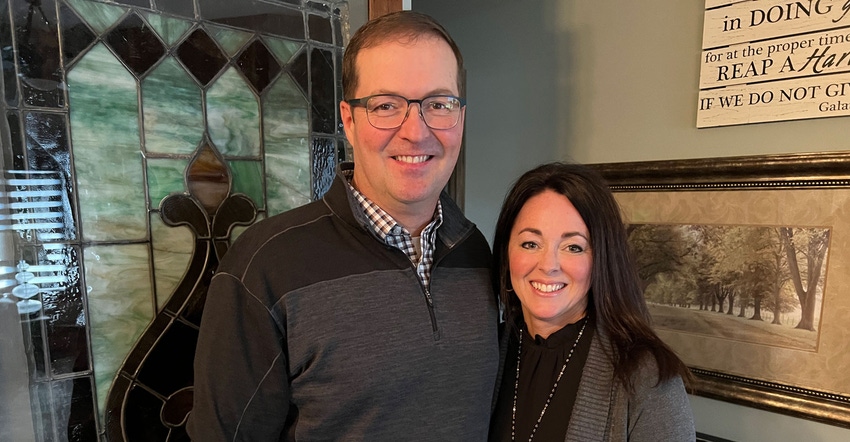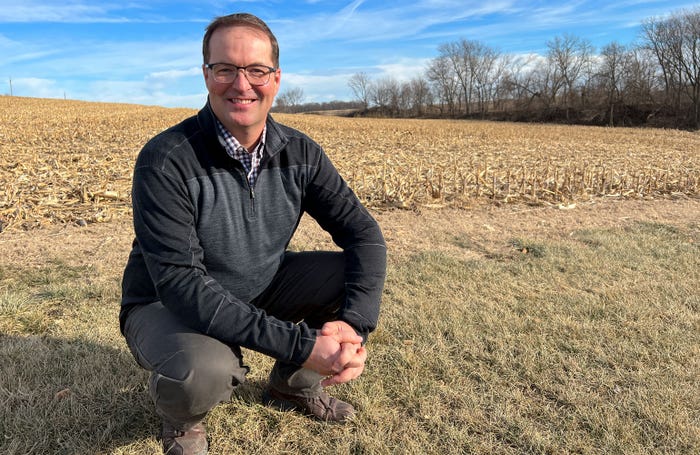March 17, 2022

Jeff Jorgenson will tell you right away: He went to college but didn't finish. Just six hours short of that degree in agronomy, the call of the farm grew too strong. "It was time to get back to the farm," he recalls.
Jorgenson farms with his wife, Jennifer, and his grandfather, near Sidney, Iowa. While his grandfather has since retired — he's 95 — he remains connected with Jorgenson. That matters, since the two have essentially farmed together since Jorgenson was 7 and lost his father to a farm accident. "It was always just me and him on the farm," Jorgenson says.
A little younger than others for the Master Farmer honor, Jorgenson is 46, but his work since returning from college has been all about growth. "We were essentially a livestock operation at the beginning," he says.
That included a 300-sow farrow-to-finish operation and a small cow herd. But when Jorgenson returned, he and his grandfather turned their attention to crops and cows, leaving the pigs behind. "It's been really just growth," he says. "We got out of the pig side of things. We custom-fed for a couple of years, and that just wasn't working. We just had other avenues to go."

The focus turned to row crops and cows. Today he says the row crop side is five times larger than when he started, and he's tripled the cow herd too. That expansion includes working with nine landowners, where he works to maintain those relationships for his farm.
Today he's farming the ground with the help of two employees, whom he praises as great to work with. Jorgenson is aware that the labor market is tight, and he works with his two to keep things moving.
Jorgenson is quick with a laugh and says that he feels fortunate now. "This is the best situation I've had, really, ever," he says. "I know it's really good in agriculture right now, but even when it's a little leaner, we just get things done, and we're enjoying what we're doing."
Jennifer works off the farm for a financial management company and enjoys that work as well.
Fine-tuning calving
"We're spring-calvers here, and we run it pretty tight," Jorgenson says. "We also graze our grass pretty tight in season. What I mean is that if it comes to late summer, we'll work into it. Our go-to is a greenchop situation to let us get through. We do push to the limit, there's no doubt about it."
That approach, and his aggressive work to grow the operation, shows the way Jorgenson invests in the farm business. He explains they'll try new products and new procedures. "We try to stay ahead, or rather, to keep up with what's going on in agriculture," he says. "You have to be ready to move quickly and not be afraid to have your own plots, have your own opportunities."
He's been using cover crops on his operation for five years. "I do like the cover crops. We've grazed them, we've made ryelage, we've done it a lot of different ways," he explains. "I like the utilization of it. We've turned cover crops into a double cropping situation for us, where we are harvesting it or grazing it."
He has some pivots on some of the land he farms, and leverages that with soybeans following corn. He can push up the rye, then take it off or terminate it and go in with soybeans, knowing he has those pivots as a backstop to get that soybean crop up.
His crop-test program is usually about what different seed companies offer, but he's doing more than small strips. "I had a guy that I guess is pretty successful tell me not to be afraid to try others, and for testing, you have to have your own field trials, and don't do it one bag at a time in a tiny strip," Jorgenson says. "I took that to heart, and that's what we started to do."
He's also spreading out nitrogen use over multiple applications from a starter to anhydrous to urea. "We use flexibility for our program, so this year we did fall application to mitigate risk," he says. "And historically we've been mostly spring-applied, but with conditions this year, fall-applied was better for us. We'll still use spring application this year, too."
Beyond the farm
And while he's been growing that farm operation, Jorgenson has been leaving the farm to work with the Iowa Soybean Association, where he served for 11 years, including as president. Recently he "retired" from that position.
"It's just crazy to talk this way, but I retired off the Iowa Soybean Association," he says. "I served my time frame there and have moved to the American Soybean Association."
He's also been active in coaching youth basketball with his children for 17 years. "And so that's over now that my son has moved to junior high; I have to retire from that," he laughs. "I'm lining up these retirements."
His move to ASA will bring national and international experience for him and his farm. "It's a philanthropic view to me is that you're working in an arena of bettering our community, and that bettering for me is Iowa farmers and U.S. farmers. If we don't work in these areas, we're not going to have good opportunities for the next generation to be in agriculture," he says.
About the Author(s)
You May Also Like






